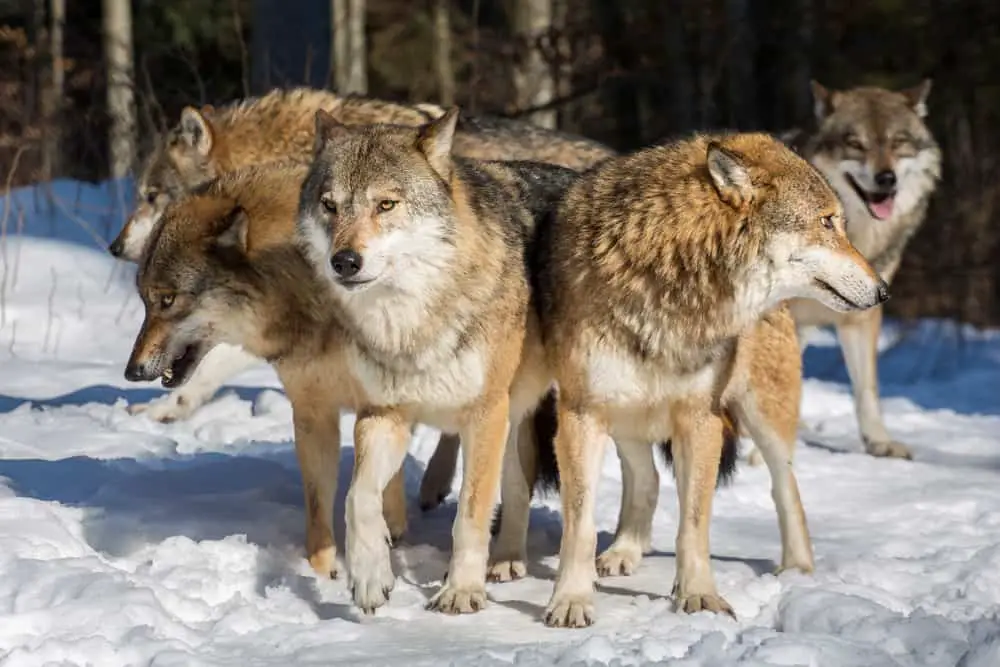
Wolves are large, carnivorous mammals that are native to North America, Asia, and Europe. They can grow to be up to three feet tall at the shoulder and weigh up to 180 pounds. In the wild, wolves usually live about eight to 13 years.
There are four main wolf species and about 40 subspecies. The most common species (and the only one indigenous to North America) is the gray wolf. The other three are the maned wolf, the Ethiopian wolf, and the red wolf.
A fifth species, the Falkland Islands wolf, has been extinct since at least 1880 because of its unusually friendly and trusting nature. This nature, unfortunately, made them easy for humans to lure and kill.
Wolves are natural-born predators; they travel and hunt in packs of anywhere from two to 30 members, but the average size of a pack is between four and nine wolves.
Wolves can run at an astonishing 37 miles per hour and cover a lot of ground. Because of this, wolf pack territories can be anywhere from 50 to 1,000 square miles. The size of a pack’s territory generally depends on the area’s availability of prey.
A wolf’s bite is extremely powerful. On average, a wolf can bite with 1,500 pounds per square inch of pressure, which is about seven times more powerful than the average German shepherd’s 238-pound bite. When hunting, wolves prefer large prey like deer, elk, moose, and buffalo, but they are also known to eat smaller prey like rodents, beavers, and rabbits as well.
Here’s a look at the animals that most closely resemble wolves.
Table of Contents
Domestic dogs
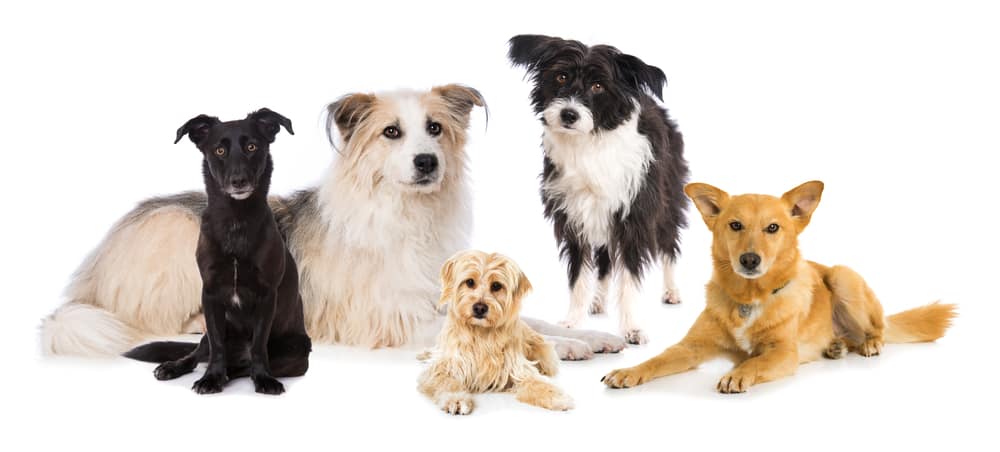
Obviously, domestic dogs are closely related to wolves. Currently, the American Kennel Club (AKC) recognizes 167 different breeds of dogs. Although domestic dogs vary wildly in size and appearance, they are actually all the same species, able to procreate with any other breed and produce viable offspring.
African wild dogs
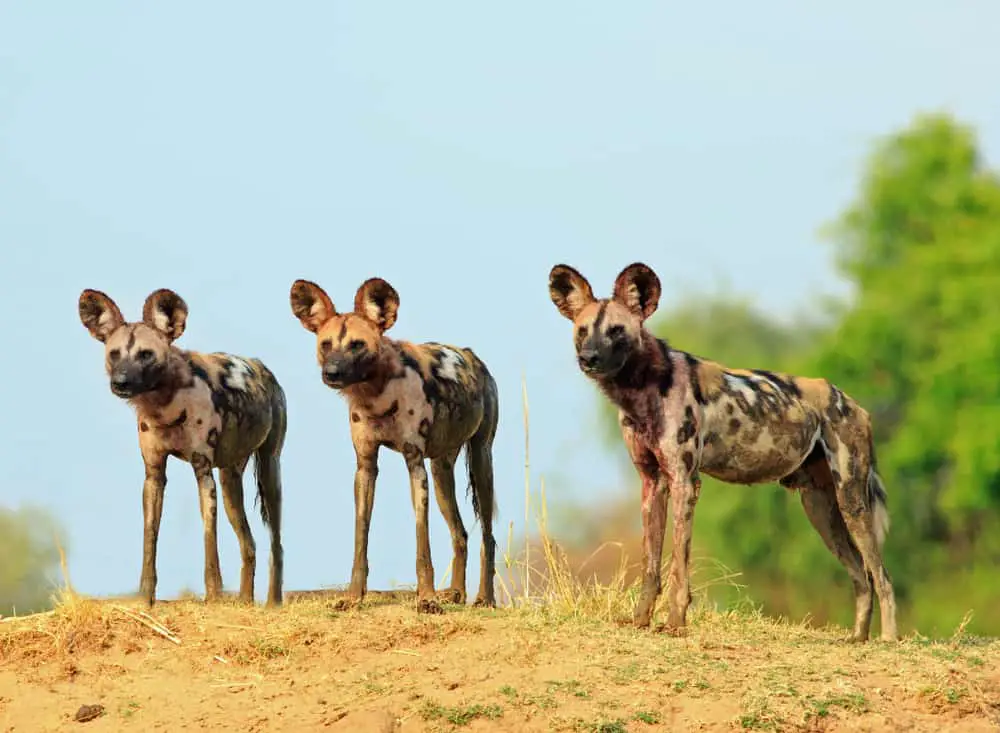
African wild dogs are an endangered species of mammal found mostly in the forests, deserts, and grasslands of southern and East Africa. The World Wildlife Foundation (WWF) estimates there are fewer than 1,500 African wild dogs left.
African wild dogs are about two to three feet tall, between three and four feet long, and weigh between 40 and 70 pounds. They typically go after medium-sized prey like gazelles, but they’re known as opportunistic hunters, so roadkill, crops, and livestock will also do in a pinch.
Like wolves, African wild dogs are pack animals. The average pack size is around 10 but can consist of as many as 40. African wild dogs have an average lifespan of 10 years.
Unlike wolves, African wild dogs have very long, slender legs. There is also a marked difference in their ears. Instead of the short, pointy ears seen on wolves, African wild dogs’ ears are large and almost perfectly round.
The main threat to African wild dogs, unsurprisingly, is humans, particularly humans whose main source of income is livestock or agriculture. Other threats to the species include habitat loss (due mostly to human development), disease, and competition with larger predators, especially lions.
Jackals

Jackals certainly resemble wolves, but there are a lot of differences. Firstly, jackals don’t get anywhere near as big as wolves. The largest jackals only weigh about 31 pounds, and it’s unusual for them to grow more than 15 inches tall.
Jackals have thin legs and bodies and dark eyes. There are three distinct species of jackals: golden jackals, side-striped jackals, and black-backed jackals. They are primarily located in Africa.
Unlike wolves, jackals seldom gather in packs. When they hunt, it is usually alone or in pairs. They also have noticeably different diets; jackals are omnivorous, and they eat all kinds of things: smaller mammals, birds, insects, berries, and even grass.
Jackals are not as fast as wolves, but they possess superior endurance; they can run about 10 miles per hour for extended periods. Jackals live an average of 10 to 12 years.
Coyotes
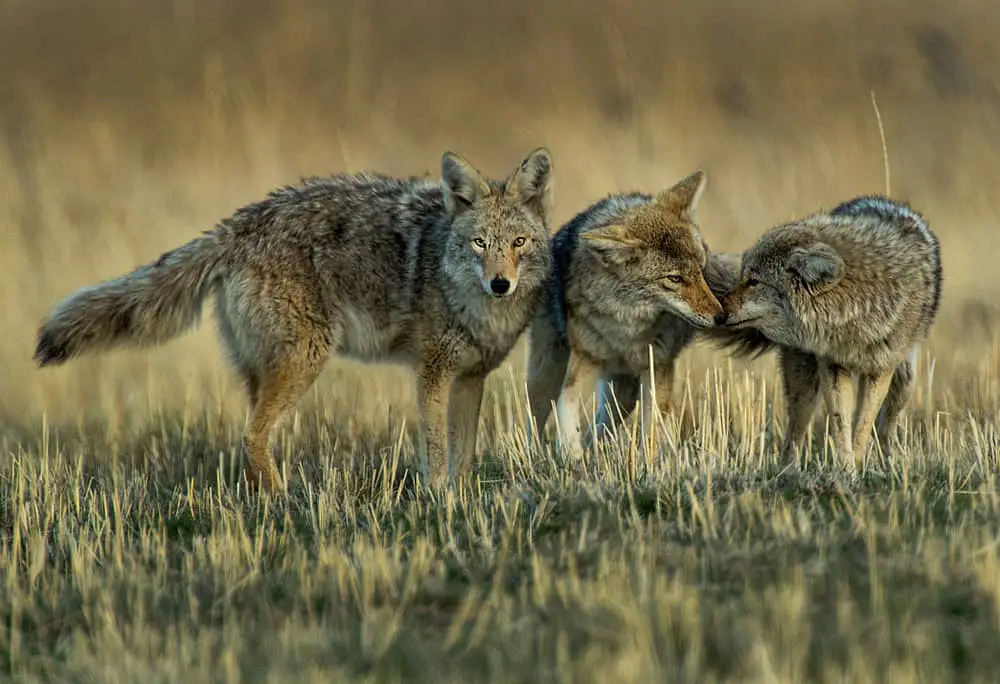
Native to the United States and Canada, coyotes can thrive in a wide array of habitats. Aside from their size, which tends to be smaller, coyotes are strikingly similar in appearance to wolves.
Coyotes can weigh anywhere from 15 to 45 pounds. Adults reach an average height of about two feet tall. Like wolves, coyotes are carnivorous, but they have a less diverse diet, mostly eating squirrels.
Coyotes are much less reclusive than wolves. It’s not uncommon for coyotes to wander into urban areas and thrive there. Unfortunately, they have been known to attack people’s pets, so they can be a bit invasive.
While in pursuit of their prey, coyotes can reach speeds of up to 43 mph. On average, they live about six to eight years in the wild, but they have lived up to 16 years in captivity.
Coyotes are not usually dangerous to humans, and there are only two reported cases of humans being killed by coyotes in the United States. Still, they can be aggressive when cornered or rabid, so people should never chase, follow or antagonize coyotes.
Foxes

There are 12 types of foxes whose features vary. For the most part, however, foxes have small triangular ears, flat skulls, and long bushy tails.
Foxes are much smaller animals than wolves; the largest foxes weigh only 21 pounds, reach a height of only 20 inches, and a length of just over two feet. Foxes seldom live longer than five years.
Although a member of the family Canidae and, therefore, related to wolves, a lot of people mistakenly think that foxes are related to cats. This makes sense; foxes share several unique characteristics with cats.
Foxes’ whiskers are much more pronounced than those of wolves, and like cats, they are able to use their whiskers for navigation. Foxes are also nocturnal, live in underground dens, and have retractable claws.
Unlike wolves, foxes do not possess a pack mentality, preferring solitude when they’re not raising their young.
Foxes inhabit much of the world. They live in nearly all of Europe, Africa, Asia Australia, and North America. Foxes can reach speeds of up to 42 mph.
From a dietary perspective, foxes are quite different than wolves. Foxes are omnivorous, and they eat a wide variety of things. The fox’s dinner menu includes but is not limited to:
- Mice
- Small birds
- Frogs
- Insects
- Vegetables
- Fruits
- Mushrooms
The most common foxes are known as red foxes. The rarest fox is known as the Sierra Nevada red fox. Found only in California, the Sierra Nevada fox is, sadly, extremely close to extinction; at most, there are only 50 Sierra Nevada red foxes left in the world, and there could be as few as 20.
Dingoes
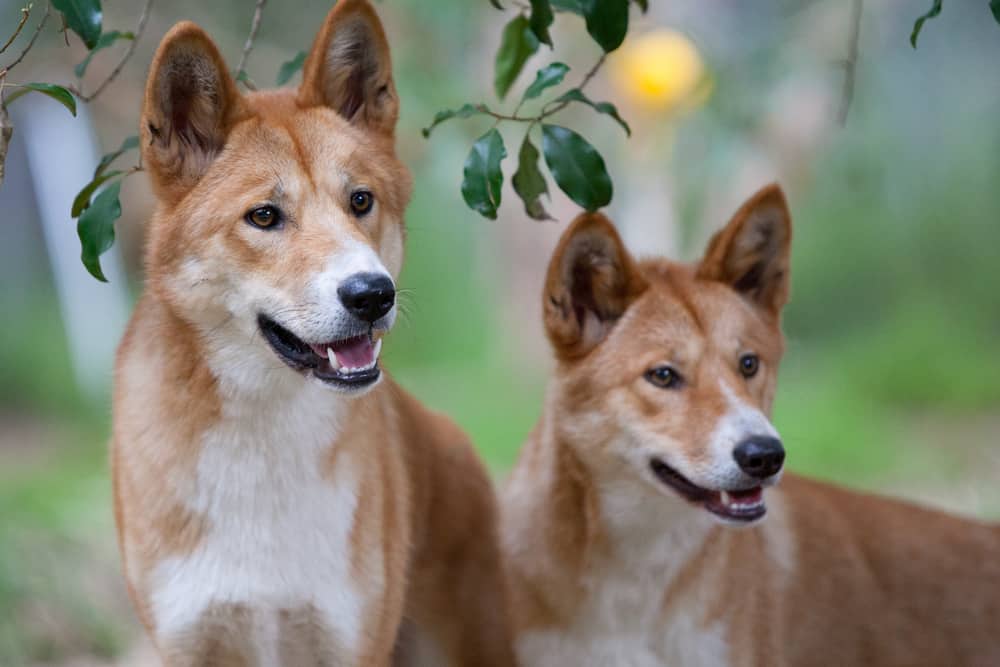
In terms of appearance and behavior, dingoes share many characteristics with wolves. Dingoes have long legs and relatively thin bodies. They can live in packs of up to 10 members and, like wolves, cover great distances.
They are also known for their wolf-like howls. Dingoes also bark, presumably to communicate with other canids.
Like most animals on this list, dingoes are smaller than wolves, reaching a maximum weight of only 44 pounds and a height of two feet tall. Dingoes are full-grown at around seven months old and live between five and seven years.
Unlikely wolves, dingoes are not particularly dangerous to humans. They tend to be timid and can even be friendly. When dingoes do attack humans, they generally attack small children.
Dingoes are known to attack cattle and other livestock, but it has been suggested that killing adult dingoes actually increases the amount of livestock lost to them. This sounds like a major contradiction, but it actually makes sense; with no parental figures to teach them how to hunt, young dingoes run amok and go after the easiest prey they can find: people’s livestock.
With the exception of Tasmania and a few other small areas, dingoes live all over Australia. Although certain dingo populations are declining, dingoes are not considered endangered; there are somewhere between 10,000 and 50,000 dingoes in Australia.
Dingoes mostly hunt and roam in mating pairs of two. Although rare, dingoes do sometimes form packs. Like wolves, dingoes are carnivorous mammals that tend to be nocturnal in warmer regions. Although they used to eat mostly kangaroos and wallabies, the diet of dingoes has shifted over the years to mostly rabbits and small rodents.
Raccoon dogs
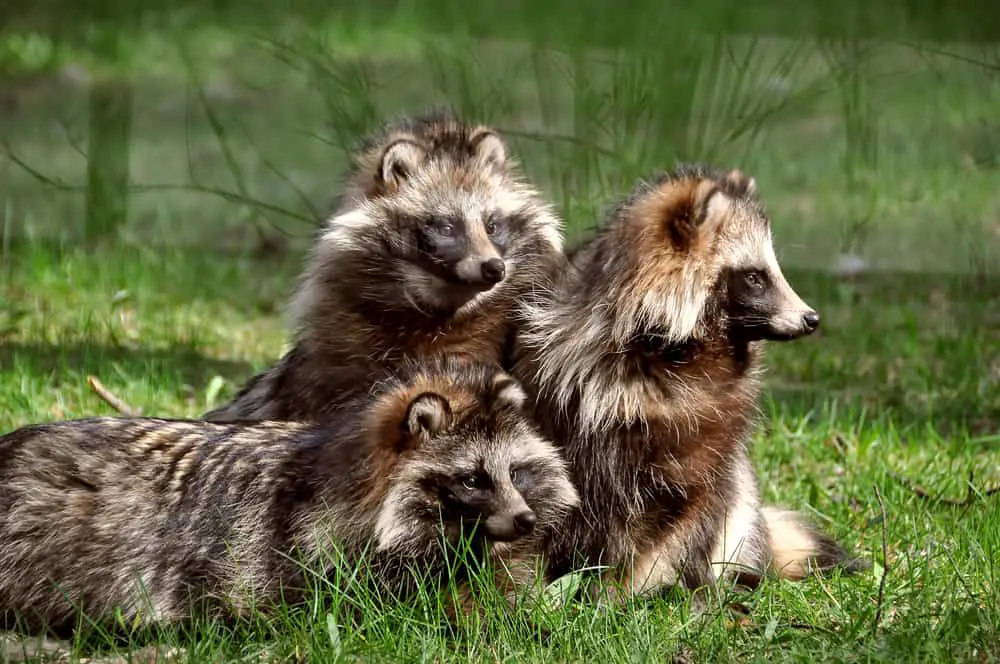
As its name suggests, the raccoon dog looks like a cross between a raccoon and a dog. The face of a raccoon dog resembles that of a dog or wolf, but its ears are more like those of Mickey Mouse: perfectly round and close together.
Raccoon dogs live in the grasslands and forests of Asia and Europe, and their population is considered steady. Far smaller than wolves, raccoon dogs don’t usually get much bigger than 10 to 12 pounds or much longer than two feet. In the wild, a raccoon dog’s life expectancy is about three to four years.
Unlike wolves, raccoon dogs are omnivorous, feeding mainly on rodents, insects, fish, nuts, berries, and fruits. They tend to live in thick vegetation where they’re harder for predators to sniff them out.
Perhaps most interestingly, raccoon dogs are completely monogamous and mate for life. This is an extremely rare characteristic in any animal; evolution tends to favor promiscuity, which allows stronger, more dominant traits to endure and hinders the passage of weaker, recessive ones.
Bush dogs
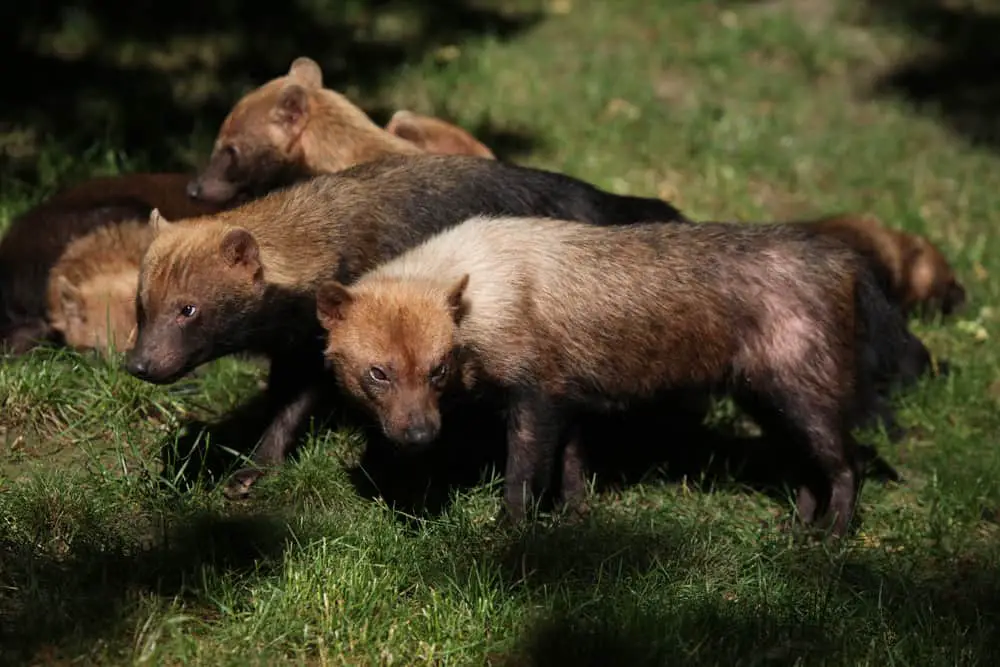
The bush dog is a difficult creature to describe, and it is perhaps the most unique animal on this list. It looks somewhat like a small wolf mixed with a wild pig. Strangely, the bush dog is the closest relative to the maned wolf.
Bush dogs are about a foot tall at most and reach a maximum weight of 18 pounds. The largest bush dogs are only about 2.5 feet long.
Bush dogs inhabit Central and South America, but they’re actually pretty rare. The bush dog’s conservation status is officially classified as near threatened. There are an estimated 110,000 bush dogs left in the world, a figure that some scientists and conservationists suggest is drastically exaggerated.
Like wolves, bush dogs are carnivores, but they feed mostly on three large species of rodents, the names of which are completely foreign to most people: capybaras, pacas, and agouti.
Bush dogs are similar to wolves when it comes to pack mentality, but it’s fascinating and a bit different; bush dog packs are the equivalent of a nuclear human family, in which only the parents and direct offspring can be members.
Although the bush dog’s usual prey is large rodents, they’re by no means pushovers. There have been numerous reports of bush dogs packs taking down formidable opponents. Most notably, there’s a report of a pack of bush dogs killing a 550-pound tapir.
That’s pretty impressive for a pack whose maximum combined weight is less than one-fifth of the weight of its prey.
Dholes
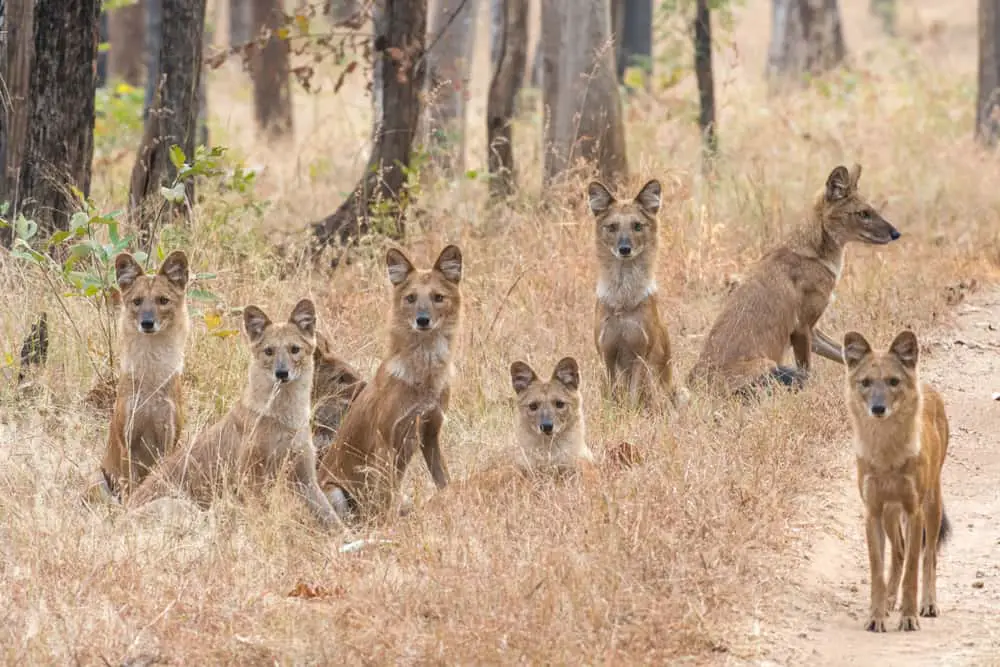
Dholes, also known as Asian wild dogs, are found in most parts of Asia and look somewhat like a cross between a wolf and a fox. Despite their relatively wide range, dholes are extremely rare; there are only about 2,500 dholes left in the world.
Dholes are considered average-sized canines, weighing between 33 and 46 pounds. They’re about 20 inches tall and have tails that can reach 1.5 feet in length. Dholes live a maximum of 15 to 16 years.
Dhole’s social behavior is interesting. Rather than running in packs, like wolves, dholes sometimes run in clans. The distinction is interesting: Clans refer to packs that break off into smaller groups during certain seasons.
Dholes hunt mainly during the day or on moonlit lights. They eat wild goats, pigs, buffalo, and deer.
The most interesting thing about dholes, by far, is their hunting behavior; they have extremely unique pre-hunt rituals. Before they hunt, dholes engage in strange sexual behavior: It involves body rubbing, nuzzling, and mounting, which can be either hetero- or homosexual.
The dens of dholes are also interesting. There are four kinds of dhole dens known to exist. The differences are subtle, but they mostly have to do with the number of entrances; dhole dens can be simple, consisting of only one entrance, or extremely complex, with four or more entrances and even interconnected tunnels.
The largest natural threats to dholes are tigers and leopards. Although formidable foes, the damage is done to the species by these predators is negligible because they have different preferences when it comes to prey.



